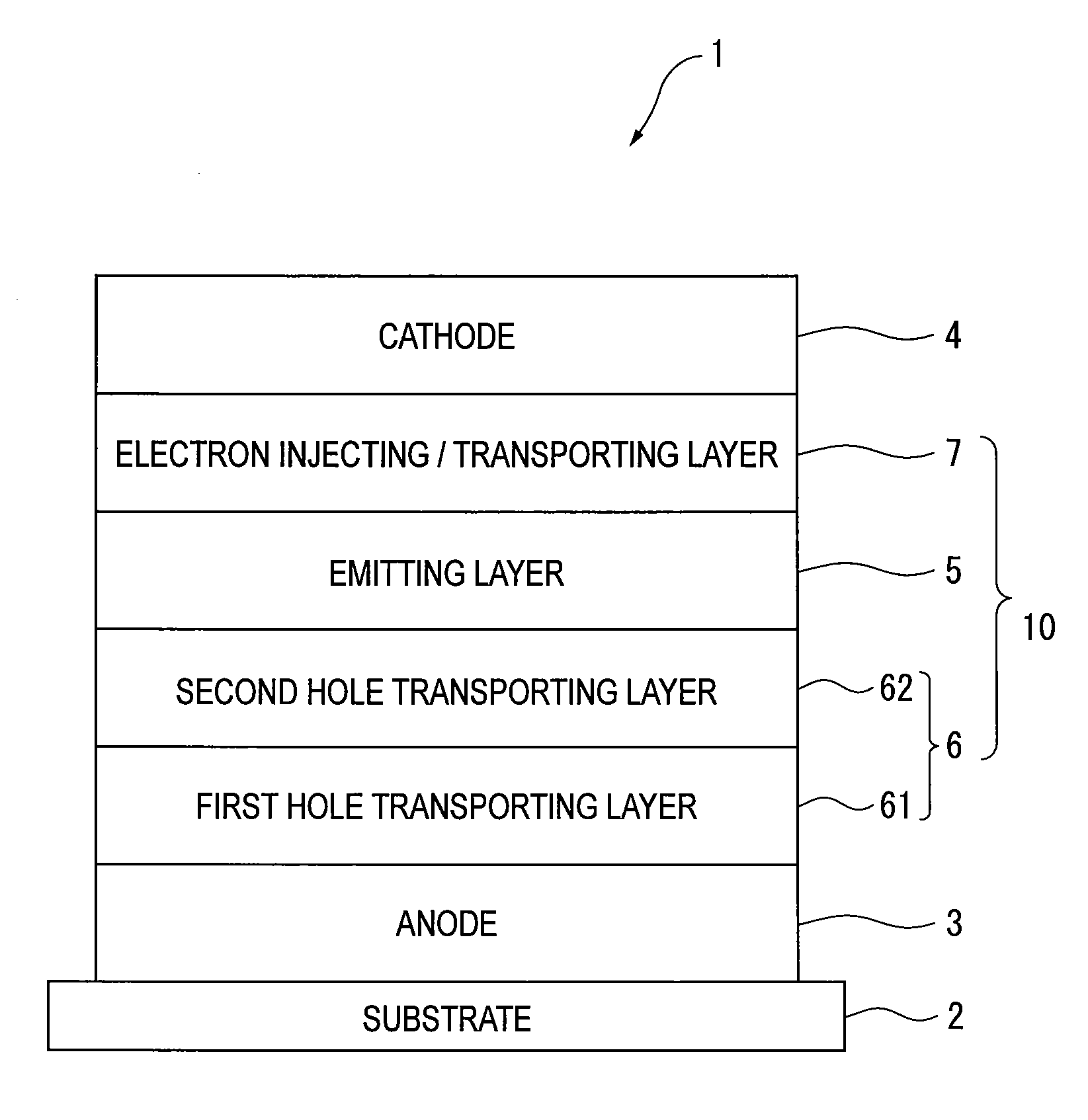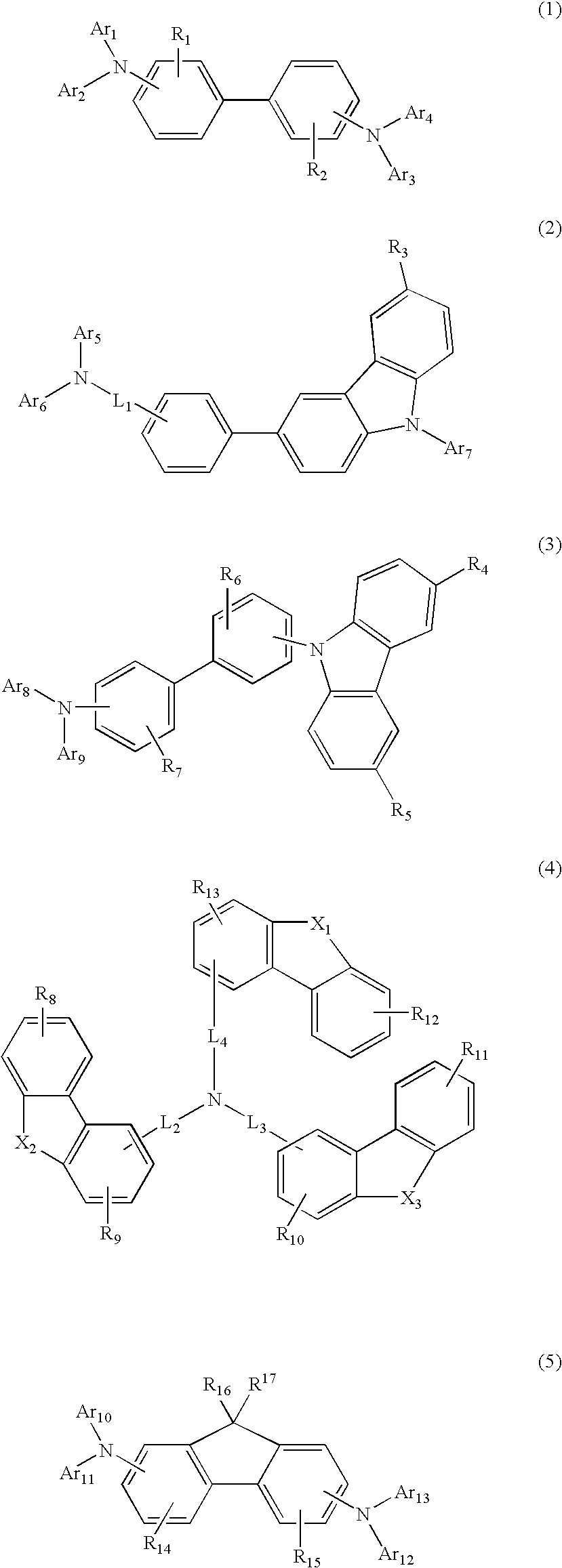Organic el device
- Summary
- Abstract
- Description
- Claims
- Application Information
AI Technical Summary
Benefits of technology
Problems solved by technology
Method used
Image
Examples
example 1
[0165]A glass substrate (size: 25 mm×75 mm×1.1 mm thick) having an ITO transparent electrode (manufactured by Asahi Glass Co., Ltd) was ultrasonic-cleaned in isopropyl alcohol for five minutes, and then UV / ozone-cleaned for 30 minutes.
[0166]After the glass substrate having the transparent electrode line was cleaned, the glass substrate was mounted on a substrate holder of a vacuum deposition apparatus, so that an 80-nm thick film of a compound HT0 was initially formed by resistance heating deposition to cover a surface of the glass substrate where the transparent electrode line was provided. This HT0 film serves as the first hole transporting layer.
[0167]After the film-formation of the first hole transporting layer, a 20-nm thick film of an electron-blocking compound HT1 was formed by resistance heating deposition to cover the film of the first hole transporting layer. This HT1 film functions as the second hole transporting layer.
[0168]Further, on the second hole transporting layer,...
examples 2 to 4
[0171]The organic EL device was manufactured in the same manner as in Example 1 except that HT2, HT3 and HT4 were used in place of HT1 as materials of the second hole transporting layer.
Comparative 1
[0172]The organic EL device was manufactured in the same manner as in Example 1 except that tris(4,4′,4″-(9-carbazolyl))-triphenylamine (TCTA) was used in place of HT1 as materials of the second hole transporting layer.
Comparative 2
[0173]The organic EL device was manufactured in the same manner as in Example 1 except that di(4,4′-(9-carbazolyl))-triphenylamine (DCTA) was used in place of HT1 as materials of the second hole transporting layer.
Comparative 3
[0174]The organic EL device was manufactured in the same manner as in Example 1 except that the hole transporting layer is a 100-nm thick single-layered film of HT3 without laminating the first and second hole transporting layers.
Comparative 4
[0175]The organic EL device was manufactured in the same manner as in Example 1 except that the ...
example 5
[0176]A glass substrate (size: 25 mm×75 mm×1.1 mm thick) having an ITO transparent electrode (manufactured by Asahi Glass Co., Ltd) was ultrasonic-cleaned in isopropyl alcohol for five minutes, and then UV / ozone-cleaned for 30 minutes.
[0177]After the glass substrate having the transparent electrode line was cleaned, the glass substrate was mounted on a substrate holder of a vacuum deposition apparatus, so that 10-nm thick film of a compound HT0 was initially formed by resistance heating deposition to cover a surface of the glass substrate where the transparent electrode line was provided. This HT0 film serves as the first hole transporting layer.
[0178]After the film-formation of the first hole transporting layer, 10-nm thick film of an electron-blocking compound HT4 was formed by resistance heating deposition to cover the film of the first hole transporting layer. This HT4 film serves as the second hole transporting layer.
[0179]Further, on the second hole transporting layer, a compo...
PUM
 Login to View More
Login to View More Abstract
Description
Claims
Application Information
 Login to View More
Login to View More - R&D
- Intellectual Property
- Life Sciences
- Materials
- Tech Scout
- Unparalleled Data Quality
- Higher Quality Content
- 60% Fewer Hallucinations
Browse by: Latest US Patents, China's latest patents, Technical Efficacy Thesaurus, Application Domain, Technology Topic, Popular Technical Reports.
© 2025 PatSnap. All rights reserved.Legal|Privacy policy|Modern Slavery Act Transparency Statement|Sitemap|About US| Contact US: help@patsnap.com



